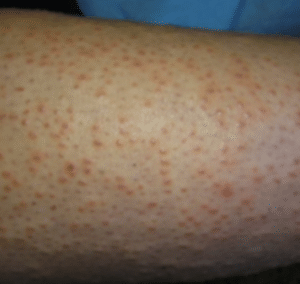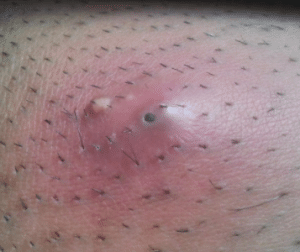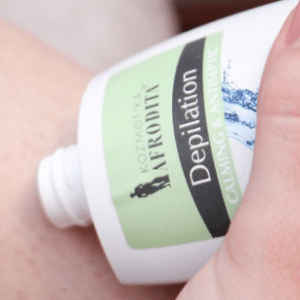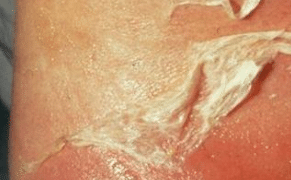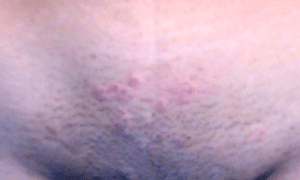What are ingrown hairs? How do they look like? How do they arise? What are the probable causes and how to get rid of them? Many people fall in confusion when a strange bump sprung up on their faces or on one of their legs or arms; whether they are just pimples, hives or something else. That could a sign of ingrown hair. Get more insights on the causes, symptoms and how to get rid.
Ingrown Hair on Leg
What are ingrown hairs?
Ingrown hairs are hairs that have curled around and grown back into your skin instead of rising up from it. Ingrown hairs arise or sprung up when a dead skin clogs up a hair follicle, this further causes the hair inside it to grow sideways under the skin, rather than upward and outward.
Sometimes, cutting naturally curling hair too closely will result in the sharpened end of the hair piercing the skin, causing an ingrown hair.
Ingrown hairs aren’t a worrisome medical condition, but sometimes they can be irritating and embarrassing.
Symptoms of ingrown hair or how ingrown hair look like
- An ingrown hair usually irritates the skin. It also produces a raised, red bump (or a collection of bumps) that looks like a little pimple. An ingrown hair sometimes can form a painful, boil-like sore.
- In most cases if you got a lot of ingrown hairs, they may turn out to be itchy and uncomfortable or you may visibly see the hair that is causing the problem.
- In men, ingrown hairs often pop up as a bunch of little bumps on the chin, or cheeks or neck after shaving.
- In women, ingrown hairs appear mostly on the legs, arms as well as in the public area and armpits.
- Ingrown hairs can also sprung out on the buttocks
- Some people may have symptoms of pus inside the bump of ingrown hair
- There is discomfort and richness in the region of ingrown hairs, especially if the ingrown hairs are in multiples
Ingrown Hair on Legs Causes
- Ingrown hair caused due to high level of sex hormones. a person with high level of sex hormones in his body tends to have excessive hair growth , this in turn increases the chances of the person having ingrown hairs especially after he has shaved.
- Ingrown hair caused due to waxing or shaving in the wrong direction. When shaving its always advisable to shave to shave towards hair growth and not against it
- Ingrown hair caused due to hair removal procedures. The very common cause of ingrown hair is wrong hair removal technique or methods such as waxing, shaving and tweezing of facial and body hair. When hair is removed through these techniques, it leaves behind a short hair with a sharp edge of the hair tip close to the skin surface, this result in hair growing and curling back into the hair follicle or grow sideways and get trapped under the surface of the skin causing an ingrown hair.
- Ingrown hair caused due to hair texture. People with very curly or coarse hair have a greater chance to have ingrown hair, this is due to the fact that curly hair tends to bend backwards and grow back into the skin especially after the hair has been shaved or cut.
- High chance of ingrown hair due to race of an individual. Many Latinos and Africa-Americans who have curly or thick hair tend to have a type of ingrown hair which in medical terms is referred to as pseudofollicutilis, or commonly known as “ razor bumps’’. This are a group of little bumps commonly occurring on the beard region after tweezing, waxing or shaving any unwanted hair. The edge of the new hair which grows back is shaper, because it can easily push back through the skin and gets trapped under the skin surface causing ingrown hair.
- Genetic predisposition. In some cases, the ingrown hair is an inherited condition. It occurs after the hair has been removed or shaved because the skin tends to grow covering the pores and the hair follicles.
- Dead skin cells in pores. If the dead skin cells are not removed on a regular basis, they may group and clog up the pores, resulting in ingrown hairs. Getting a gentle skin peeling solution and using it three times a week can help solve this problem.
- Oil in the hair follicles. Oil gathering in the hair follicle may cause ingrown hair due to a hormonal problem, hyperthyroidism, and poor hygiene, use of unsuitable moistening creams that makes the skin oily or excessive production of skin oils.
- Dry skin. People with dry skin, both men and women, are more at the risk of getting ingrown hair due to the fact that there will be a lot of dead skin cells which may often cover the hair follicles preventing hair to surface. This problem can be solved by proper moisturizing of the skin and frequent use of creams that will keep the skin moist.
- Having naturally coarse hair.
- Tight clothing and synthetic fabrics like nylon leggings, skinny jeans and polyester underwear can increase chances of ingrown hairs. It’s best to stick to easy cotton clothing that is not air-tight and won’t rub against your skin.
- Not exfoliating regularly after hair removal. After hair removal, it is advisable to exfoliate your skin with antiseptic skin soothing ingredients like green tea and tea tree extracts.
Infected Ingrown Hair Cyst on Legs
An ingrown hair cyst occurs mostly in regions where the hair has been removed either through tweezing, waxing or shaving. The mostly affected areas include the inner thighs under the chin, groin, neck, and face.
Infected ingrown hair cyst are very painful to get rid of, cyst may also cause tenderness, a lot of itching, bruising on the adjacent areas.
An infected ingrown hair cyst is usually filled up with yellow pus, a factor that increases the degree of itchiness and inflammation. This condition makes one uncomfortable and therefore, there is need for its urgent removal. An infected ingrown hair cyst on legs can be removed through the procedure below:
- Use a disinfectant such as antibacterial soap to clean the affected area.
- Using warm water and a clean wash cloth, warm compress the affected area. Repeat the same process several times.
- Remove the ingrown hair cyst using a pair of tweezers and a needle, prick the affected area. Use the tweezers to grab and uproot the whole ingrown hair.
- Drain the cyst for it to heal faster.
- Disinfect the affected area and leave it to dry. Avoid touching the area with contaminated hands as this can result to an infection.
How to get Rid of Ingrown Hair on legs
Exfoliating the skin to get rid of ingrown hair on legs.
- Gently exfoliate your leg skin twice a day using salt or a mixture of olive oil or sugar.
- This helps in removing accumulated dead skin cells, oil and dirt and also prods the hair tip out of your leg skin.
- Exfoliate gently at the area of ingrown hair from different directions to help remove it from the skin.
Using egg membrane to get Rid of Ingrown hair.
- Remove an egg membrane from inside an egg shell.
- Cover the ingrown area of the leg with the egg membrane.
- Keep it for some time until it dries and shrinks up.
- Gently peel off the egg membrane and the ingrown hair will come out with it.
Using lukewarm milk to get rid of Ingrown Hair.
- Heat some milk till it is lukewarm.
- Dip a piece of bread in this milk
- Place this piece of bread on the ingrown hair or hairs and leave it there till it cools down
- Repeat the same process above for the next eight minutes. This will help open up the hair follicle.
- Check the ingrown hair after eight minutes lapses .if the loop of hair is visible, then with the help of a needle, free the trapped hair.
Use warm compress to get rid of Ingrown hair.
- Use a warm compress against the ingrown hair to try to soften the skin and hair follicle, this helps to bring the hair to the surface.
- Using a sterile needle or tweezers, gently tease the trapped ingrown hair out of the skin.
- If you can’t easily remove the hair, avoid digging deep into the skin to remove the hair.
- While doing all this you need to be gentle and patient as it can take time to remove the ingrown hair out of the skin.
- Do not in any way cut the skin in order to remove the ingrown hair.
- If you observe a loop of the hair near the skin’s surface, it means that the tip of the hair has started to grow down towards the skin. Try to put the needle in the loop and gently pull, it will bring the end of the ingrown hair loose.
How to prevent Ingrown Hair on legs
Consider the following way and options on how to prevent ingrown hair which have been researched on by America Academy of Family physicians (AAFP) and published in a refereed journal , Dermatologic Therapy, and further presented at the American Osteopathic College of Dermatology. Below are ways on how to prevent ingrown hair:
- Avoidance of topical products that cause irritation to the skin. Any product with alcohol has the potential to make ingrown hair problem to worsen with more irritation.
- Loosen any embedded hair before shaving. Exfoliating the skin area before shaving can loosen up hair that may already be tapped in the follicle.
- Shave in the right direction of hair growth. Shaving in the right direction of the hair growth encourages hair from growing outward, rather than inward hence preventing ingrown hair.
- Change your skin products. Change your skin products if they are completely drying your skin , as dry skin increases irritation on the already existing ingrown hair.
- Rinsing the blade. After every stroke of shaving, rinse the blade with water and also use warm water to wet your skin and further apply a lubricating gel before shaving. All this in will help to prevent ingrown hair.
- Use steam to soften your skin before shaving. Dry and tight skin helps in the growth of ingrown hair. Shave after a hot shower to take advantage of the steam effect on your ski and leg hair.
- Wait longer before shaving. Keeping long leg hair is the best way to avoid ingrown hairs. Always give your hair and skin some time before shaving. Avoid shaving every time.
- Use hair removing creams instead of shaving. Creams work by removing hair beneath the surface of the skin. This helps to prevent ingrown hair.
- Put a warm washcloth on your leg or a soft toothbrush after shaving. After soaking a washcloth in warm water, apply it to the ingrown hair to warm and relax the hair follicles and spores. Rubbing in a gentle circular motion may help uncurl the hair.
- Don’t shave too closely. Mostly use an electric razor if you are having difficulty of removing your long hair with a manual razor.
- Post-shave treatment. There are many` post-shave ’products in the market such as Aloe Vera creams and glycolic acids both of which have ability to dissolve any build up dead skin cells from the surface of the dermis and prevent skin pores from clogging and growth of ingrown hairs.
- If you want to shave, use the best blade. Make sure you buy a couple of extra razor heads so you aren’t tempted to use and re-use the same one over and over.
Bad Ingrown Hair on legs
A bad ingrown hair on legs happen when an ingrown hair, is surrounded by infected bacteria attacking cells. As blood flow increases, there is release of chemicals to the affected area and this simultaneously stimulates growth of abnormal hairs.
Lots of Ingrown Hair on legs
The problem of having lots of ingrown hair on legs affects majorly older people, this is because the natural skin renewal process slows down as people grow older, and also the production of skin natural oil-sebum slows down. This result in dead skin cells building up on the outer surface of the skin making it difficult for hair to grow normally. Lack of moisture in the skin affects skin’s natural defense and healing mechanism this further promotes growth of lots of ingrown hair on legs.
Ingrown Hair on legs after Waxing
Removing hairs from your legs using conventional forms of depilation can such as waxing can put you at an increased risk of having ingrown hair. Waxing leaves the hair follicle with a sharp tip that is highly likely to curl back into the skin when it grows back, often resulting to irritating acne-like pustules.
The following are ways to get rid of ingrown hair on legs caused as a result of waxing:
- Apply an aspirin based anti inflammatory mixed with glycerin oil to the ingrown hairs.
- Use an over-the counter cortisone cream if ingrown hair bumps are unresponsive to aspirin- based topical.
- Wash the affected area twice a day to make the area soften so that it can release any ingrown hair that is trapped.
- Apply antibacterial cream.
- See a doctor if the ingrown hairs continue to be a problem or if the infection is not fading away with home treatment.
Ingrown Hair on Thighs male
An ingrown hair on thighs in male may occur after removing unwanted hair from your thighs a factor that cause and makes it easier for curly hair to re-grow and re-enter your skin, this results to inflammation in the affected area.
How do you treat Ingrown Hair on legs
In most cases ingrown hair sprung out naturally. Ingrown hairs cause inflammation, pain, itchiness and irritation. It is common practice to place a warm washcloth on the infected area several times a day for relief. For chronic inflammation and infections, the use of topical anti-bacterial cleansers may be used to provide relief and help in the healing process.
Below are some of the best ingrown hair treatments:
Topical treatment
Examples of topical or over-the-counter medications include corticosteroid creams, topical anti-biotic creams and retinoid creams which can help to cure minor infections.
Corticosteroid creams can ease the itchiness and inflammation associated with infected ingrown hair on legs and general body.
Topical anti-biotic creams helps in the healing process when they are places on the surface of the infected area. Retinoid creams remove dead skin cells this allows ingrown hairs to break through the skin.
Lifestyle Changes
Stop wearing clothes that are too tight or uncomfortable. Tight clothing have a tendency of pressing the hair against the skin or prevent the hair from breaking through the skin properly, these therefore increases the risk of ingrown hairs.
Before waxing, shaving or tweezing allow the hair to grow for several weeks. Also on weekly basis exfoliate the skin, change razor blades when they become dirty ,dull or worn .
Before removing any hair, soak the area in warm water for approximately six to ten minutes this will help to reduce skin inflammation and irritation.
Oral medications
Several cases of ingrown hairs may require the use of oral antibiotics to prevent new infections or existing infection. Oral anti-biotic are often used to treat bacterial infections that can occur when hair follicle becomes blocked and inflamed. Without proper treatment these bacteria can spread to the surrounding skin causing cellulites infection which is a more serious bacterial infection.
Electrolysis
This is a cosmetic procedure which can help reduce the growth of ingrown hair on legs. Electrolysis occurs when a mild electric current flows through the hair follicle from a small metal probe. The current destroys the ingrown hair together with the hair follicles.
Ingrown Hair cream
For complete treatment and elimination of ingrown hair on legs , armpits , on the groin, buttocks ,public area or any other affected part of your body, the creams listed below are very effective and efficient in that regard.
Medi paste
Medi paste is a highly concentrated creamy solution which helps to eliminate ingrown hairs, razor bumps and pimples. The solution is scientifically formulated with Tea Tree oil and vitamin A to draw out the infection rapidly without causing inflammation or trauma to the skin. This cream also reduces redness and swelling of the affected area.
This creamy solution is suitable for all areas of the body and always use as prescribed by your doctor especially to those pregnant or breast feeding.
Concentrated serum
This cream provides some form of calm and relaxation to the skin after any form of hair removal. It prevents ingrown hairs from developing and soothes shaving rash. The cream is formulated with natural fruit acids to help reduce ingrown hairs by gently exfoliating skin cells that block spores and by preventing the cycle of natural hair growth.
It’s advisable to apply the cream after showering or as when required or prescribed. When applying to the skin, massage in circular motion the affected area until the cream is fully absorbed.
Zesty wash
Zesty wash works by cleaning the skin and removes excessive oils from the skin follicles and reduce ingrown hairs, bumps and breakouts.
Exfoliating mitt
The bump exfoliating mint is unique blend of fibres that massage away dead skin cells, improve circulation and leave skin feeling soft and smooth. It also help to reduce chances of ingrown hairs by preventing hair from being tapped under accumulated dead skin cells.
Triple action lotion
As a natural extract it’s always used after hair removal. It helps to retard ingrown hair by weakening already exposed hair follicle. It is also ideal for hair that is strong and coarse.
Cool splash
It is formulated with natural fruit acids; it soothes the skin and reduces the appearance of redness. It is also ideal for use on face, neck, and chest and suitable for all parts of the body. Cool splash is highly recommended for use after shaving, laser and electrolysis.
More references
- Ingrown hairs-NHS Choices nhs.uk
- How to prevent ingrown hairs cosmopolitan.com
- Mario Badescu skincare blog https://blog.mariobadescu.com
- Ingrown hair causes, Symptoms, Treatment emedicinehealth.com
- How to handle an ingrown hair drozthegoodlife.com
- Ingrown hair and how to deal with them https://gillettevenus.com


